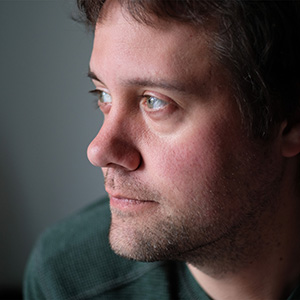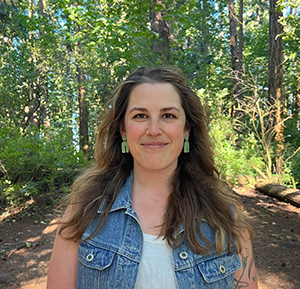A Constellation of Small Things: Rebecca Rogerson interviews Matthew Hollett

Poetry Editorial Board intern Rebecca Rogerson talks with Matthew Hollett, poetry judge for our 2025 Open Season Awards (accepting entries now). They discuss art as fundamentally collaborative, poetry’s capacity for playfulness, and his most recent book, Optic Nerve.
Matthew Hollett is a writer and photographer in St. John's, Newfoundland (Ktaqmkuk). His work explores landscape and memory through photography, writing and walking. Optic Nerve, a book of poems about photography and visual perception, was published by Brick Books in 2023. It was shortlisted for the J.M. Abraham Poetry Award, and longlisted for the BMO Winterset Award. Matthew won the 2020 CBC Poetry Prize, and has previously received the NLCU Fresh Fish Award for Emerging Writers and The Fiddlehead's Ralph Gustafson Prize for Best Poem. He is a graduate of the MFA program at NSCAD University.
What are you looking for in a winning entry? What feels exciting for you to read?
In art school I was enamoured with conceptual art, and I remember being particularly struck by a quote from John Baldessari. I’ve just looked it up again: “I think one of the purposes of art should be to keep us perceptually off balance.” Funnily enough, I always thought it was perpetually off balance—I think I’ve been remembering it wrong for 20 years! My ideas about art are probably skewed accordingly.
I came across an echo of this idea in Sheila Heti’s book The Chairs Are Where the People Go, in which she quotes Misha Glouberman: “Art is communication made in the hope that interesting miscommunications will arise.” I love how concisely this encapsulates ideas of play, humour, and seeing things obliquely. I also appreciate how it understands art to be fundamentally collaborative.
“Miscommunication” is also a fascinating idea when applied to language, because as a writer you often really do want to be clear. When writing an essay, for example, it helps to say exactly what you mean. Poetry is less straightforward, and has such a profound capacity for playfulness. What is a metaphor, if not purposeful miscommunication? I think that’s one reason I’m drawn to poetry, as a writer with a background in art—like visual art, poetry is better at questioning than answering.
Which reminds me of another quote that made an impression on me when I was still so impressionable: “Always the more beautiful answer who asks the more beautiful question” (e e cummings). I’m excited when a poem unbalances me with unexpected, playful—and yes, beautiful—questions.
In the past, you’ve talked about walking as an art practice, and how significant that practice is to you for both writing and photography. The poems in your most recent collection, “Optic Nerve,” have a certain cadence and rhythm to them—a jauntiness, if you’ll indulge me. How do you think a place-based practice, like walking, can influence the soundscape of a poem?
There are so many good walking words, and “jaunt” is a favourite for sure! I’m working on a new collection of poems about walking, so I’ve been thinking about these kinds of questions a lot. The steady pulse and propulsion of travelling by foot certainly lends itself to poetic metre (groups of syllables are called “feet” for a reason!), and can show up as sound patterns or a consistent beat. I also find myself writing longer poems, with shorter lines. And occasionally letting the poems wander off-track a bit.
I often make notes on my phone when walking or hiking, and those firsthand impressions—of sights, sounds, or other sensory input—frequently show up in my writing. Writing details down in the moment feels essential. If I try to remember or imagine things afterwards, they never feel as convincing or true.
Walking also leaves its impression in poetry as a useful metaphor—for time passing, change, travel, conversation, touch, for choosing slowness, for leaving a trace. The more I think and write about walking, the more it becomes a kind of credo, an overall way of being in the world.
There is often a playfulness to your poems; they are funny—filled with wordplay, references and clever juxtapositions—without being "funny poems." What role does humour play in poetry, for you?
It’s about unexpectedness. I like trying to see things in a new way, as if for the first time. Humour or whimsy is one way to do that—a punchline can leave you reeling, reconsidering how you thought the world was organized. A good poem has to be more than a punchline, but getting back to the “interesting miscommunications” idea, humour is such a useful tool for conveying ideas. It can help people see and understand things differently in a way that feels inviting and inclusive, rather than preachy and off-putting.
When I’m reading my work for an audience, I often choose more playful poems. The immediate feedback of laughter (or at least a chuckle or two) is satisfying, and levity also feels like a way of reaching folks in the audience who might think of poetry as dour or boring.
Cameras, and the art of photography, play a significant role in “Optic Nerve,” and in your own artistic practices. Some poems, like “Suomi Snowball,” are a collage of snapshots, both seen through and seen with the lenses of various cameras. Others, like your ekphrastic poems after André Kertész, enter into photos and the photo-taking process of another artist. What sorts of linkages, or dissonances, do you see between photography and poetry? How does the camera influence how you look at things, how you see things?
In terms of pure form, I think of both poems and photos as “small”—as opposed to the grandness of things like novels or paintings. For me, both poetry and photography involve creating a constellation of small things. It’s more about an ongoing daily practice than a single ambitious statement. Both photography and poetry also have a concision and a connectedness that really resonates with me.
I love your question about how a camera influences how I look at things. Over the course of writing Optic Nerve, I realized how much I enjoy looking closely at small details. In photography this can happen through magnification, such as with a macro lens. In writing, looking closely can take various forms—some of my poems explore overlooked surfaces such as moss or dust, for example. Others are written in response to art, which involves sustained attention and close reading.
Being a photographer makes you very aware of how images are composed—what’s not in the picture is often as important as what is. What am I including, what am I leaving out? When I look through a camera I ask myself these kinds of questions, which often have correlations in writing: What’s in the foreground, or in the background? What if I change my perspective, looking at something from a higher or a lower point of view? Where is the light coming from? What story am I trying to tell?
In a previous interview, you mentioned you’ve been working on the poems in Optic Nerve for nearly two decades, revising, revisiting, and re-envisioning them. Can you speak more to this process? What’s the best piece of advice you have for writers struggling with revisions?
It’s not that any particular poem took decades, it’s just that it took that long for the collection to take the shape of a book. But there are certainly poems that I wasn’t happy with until I took an axe to them many years after they were first written, and chopped them down into something better.
It sounds silly, but some of the best advice I’ve figured out over the years is “take out the boring parts.” Sometimes you need some distance from the poem before you can come back to it and see what isn’t necessary, or isn’t working, or is overly self-indulgent. Even stepping away from a poem for a week can help you see it with fresh eyes. And reading aloud always, always helps.

Rebecca Rogerson









